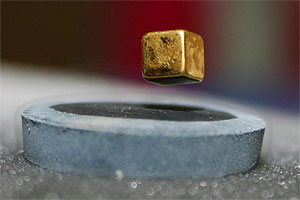 A magnet is suspended over a liquid nitrogen cooled
A magnet is suspended over a liquid nitrogen cooled
high-temperature superconductor (-200°C). Image source:
Wikimedia
Take a familiar metal, such as the aluminum foil from the bottom drawer of a kitchen, the mercury you might find in a household thermometer, or the titanium used to build an expensive road bike. Cool it enough, and you will find almost miraculously that electricity can be sent though the metal without losing any of its energy.
This effect, known as superconductivity, has tantalized physicists with theoretical weirdness and seduced futurists with potential applications since its discovery in 1911. Some of the applications, particularly in magnetism, have already been realized. A typical MRI machine works because, hidden within its outer casing, electricity is pumped through a superconducting wire maintained 10 times colder than the average temperature of Pluto. The soon-to-be-running Large Hadron Collider at CERN in Geneva would not have been possible without the aid of giant superconducting magnets. Scientists at the High Field Magnet Laboratory in the Netherlands have even used superconducting magnets to suspend a living frog.
Even more exotic and exciting ideas have been dreamed up, such as large-scale lossless power transmission networks or commercially-viable magnetically levitated trains. Many of these have remained elusively beyond the cusp of practicality. This is because most materials become superconductors only in the frigid neighborhood of absolute zero (0-10 Kelvin). A few do have higher transition temperatures. For example, the cuprates, a class of material based on copper and oxygen, become superconductors as high as 133 Kelvin. Unfortunately, these are also brittle, difficult to work with, and bear limited current loads. However, times may be changing.
In February of last year scientists discovered a new candidate in their quest for a better superconductor, a material based on iron and arsenic. That's right-- it is possible that one of the most promising candidates for next-generation energy technology is at least partly the same stuff Aunt Abby used to poison Mr. Witherspoon. The new class of material, collectively known as the iron pnictides (pronounced "NICK-tides"), has taken the physics community by storm, inspired more than a thousand research publications and stolen the show last month at the world's largest annual gathering of materials scientists, the American Physical Society March Meeting.
Is all the hype really merited? Maybe.
